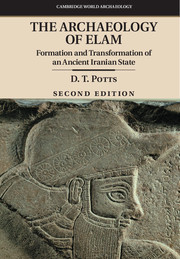Book contents
- Frontmatter
- Dedication
- Contents
- List of illustrations
- List of tables
- Preface to the second edition
- Preface and acknowledgements
- Acknowledgements for photographic reproduction
- List of abbreviations
- Note on transliteration and dating systems
- 1 Elam: what, when, where?
- 2 Environment, climate and resources
- 3 The immediate precursors of Elam
- 4 Elam and Awan
- 5 The dynasty of Shimashki
- 6 The grand regents of Elam and Susa
- 7 The kingdom of Susa and Anshan
- 8 The Neo-Elamite period
- 9 Elam in the Achaemenid empire
- 10 Elymais
- 11 Elam under the Sasanians and beyond
- 12 Conclusion
- References
- Index
5 - The dynasty of Shimashki
Published online by Cambridge University Press: 18 December 2015
- Frontmatter
- Dedication
- Contents
- List of illustrations
- List of tables
- Preface to the second edition
- Preface and acknowledgements
- Acknowledgements for photographic reproduction
- List of abbreviations
- Note on transliteration and dating systems
- 1 Elam: what, when, where?
- 2 Environment, climate and resources
- 3 The immediate precursors of Elam
- 4 Elam and Awan
- 5 The dynasty of Shimashki
- 6 The grand regents of Elam and Susa
- 7 The kingdom of Susa and Anshan
- 8 The Neo-Elamite period
- 9 Elam in the Achaemenid empire
- 10 Elymais
- 11 Elam under the Sasanians and beyond
- 12 Conclusion
- References
- Index
Summary
Puzur-Inshushinak's reign was followed by a period of renewed Mesopotamian control over Susa, this time by a dynasty established by Ur-Namma at Ur in southern Mesopotamia around 2100 BC which lasted for almost a century (the so-called Third Dynasty of Ur or Ur III empire). Apart from controlling Susa, the Ur III state entered into relations with other Iranian regions such as Anshan and its neighbours on the Iranian Plateau through a pattern of dynastic intermarriage with local elites.
But as texts from the mid to late Ur III period show, a new power identified with Shimashki was on the rise in western Iran, no doubt partly as a reaction against Ur's political imperialism. It is important therefore to investigate the role played by Elam in general and Shimashki in particular in the eventual downfall of the Third Dynasty of Ur around 2000 BC, particularly the contribution made by Kindattu, the sixth king mentioned in a list of the kings of Awan and Shimashki found at Susa. Shimashkian influence in the wake of Ur's collapse, while difficult to gauge accurately, clearly extended beyond the confines of Susiana. The difficulty of defining the boundaries of Shimashkian influence makes it awkward to point to specific archaeological assemblages from Fars and Khuzistan which can be associated with Shimashki, but it is important to keep the political history of the period in mind when assessing the material culture of the late third and early second millennium BC. It is also important to bear in mind what the relative contributions of the Iranian highlands and lowlands may have been in the often shadowy political processes which we seek to follow at this time.
Susa, Anshan and the Third Dynasty of Ur
As we have seen, Puzur-Inshushinak's westward expansion was checked by Ur-Namma, founder of the Third Dynasty of Ur. His defeat signalled a loss of those east Tigridian and central Babylonian areas which he had formerly held and also marked Susa's loss of independence, opening the way for Mesopotamian attacks deep into Iranian territory and ushering in an era which would witness the vassaldom of Anshan.
- Type
- Chapter
- Information
- The Archaeology of ElamFormation and Transformation of an Ancient Iranian State, pp. 123 - 147Publisher: Cambridge University PressPrint publication year: 2015



